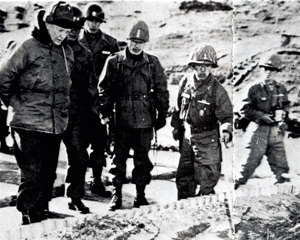Good morning, Whitewater.
Saturday in Whitewater will be partly cloudy with a high of forty-three. Sunrise is 7:04 AM and sunset 4:22 PM, for 9h 17m 58s of daytime. The moon is a waxing gibbous with 51.5% of its visible disk illuminated.
On this day in 1952, President-Elect Eisenhower visits Korea:
In late 1952 Eisenhower went to Korea and discovered a military and political stalemate. Once in office, when the Chinese began a buildup in the Kaesong sanctuary, he threatened to use nuclear force if an armistice was not concluded. His earlier military reputation in Europe was effective with the Chinese.[150] The National Security Council, the Joint Chiefs of Staff, and the Strategic Air Command (SAC) devised detailed plans for nuclear war against China.[151] With the death of Stalin in early March 1953, Russian support for a Chinese hard-line weakened and China decided to compromise on the prisoner issue.[152]
In July 1953, an armistice took effect with Korea divided along approximately the same boundary as in 1950. The armistice and boundary remain in effect today, with American soldiers stationed there to guarantee it. The armistice, concluded despite opposition from Secretary Dulles, South Korean President Syngman Rhee, and also within Eisenhower’s party, has been described by biographer Ambrose as the greatest achievement of the administration. Eisenhower had the insight to realize that unlimited war in the nuclear age was unthinkable, and limited war unwinnable.[152]
A point of emphasis in Ike’s campaign had been his endorsement of a policy of liberation from communism as opposed to a policy of containment. This continued to be his preference despite the armistice with Korea.[153] Throughout his terms Eisenhower took a hard-line attitude toward China, as demanded by conservative Republicans, with the goal of driving a wedge between China and the Soviet Union.[154]
Here’s something good ahead, in just about a year from now:
It’s just one trailer, but it looks promising.

